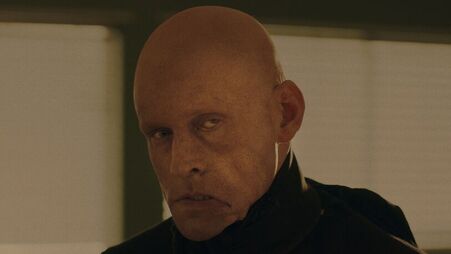[Review] 'Smiley Face Killers' is a Morbid Ride Exploring Societal Discounting of Men as Victims12/7/2020  Is there anything more frustrating than trying to convince doubtful friends and loved ones that something you’ve seen or heard, something you’ve experienced, actually happened?... ...That fiery, full body sense of injustice when your truth is met with raised eyebrows, rolled eyes, and “yeah, okays.” How about trying to convince yourself of that very same reality? Being confronted with something so preposterous or arcane you can’t concede its veracity, yet all the evidence is right there... In Tim Hunter’s Smiley Face Killers, based on a screenplay by Bret Easton Ellis of American Psycho fame, college student Jake Graham (Ronen Rubinstein) struggles to admit to himself that he is in danger after experiencing a series of strange, increasingly sinister events, and then faces the uphill battle of getting his friends to acknowledge the vaguely threatening pattern as well. This is easier said than done—Jake has struggled with depression and mental illness in the past and seems to be in the midst of another episode. Best friend and soccer teammate Gabriel (Amadeus Serafini) insists Jake has been “bummed out” lately, and girlfriend Keren (Mia Serafino) is worried that with Jake abandoning his medication, he may say and do things he later doesn’t remember, as has happened before. It all makes for a perfect storm when Jake starts receiving ominous text messages and notices he’s being followed by a creepy white van. A foreboding map left on Jake’s bed marks the location of a series of suspicious drownings, and Jake begins to fear he’ll be next. Yet he’s hesitant to jump to the worst possible conclusion. After all, couldn’t this be an ill thought out prank from his roommate Devon (Daniel Covin), whom Jake’s been butting heads with? Or maybe Keren’s ex-boyfriend Rob (Cody Simpson) is messing with him? After all, who’d want to hurt a nice, normal guy like him? Smiley Face Killers is based on a popular yet controversial theory posited by retired NYPD detectives Kevin Gannon and Anthony Duarte and St. Cloud State University criminal justice professor Dr. Lee Gilberston that the drownings of between 50 and 200 young men in several Midwestern states between the mid-1990’s and late 2010’s were not in fact accidental but the work of a serial killer or killers. The moniker derives from a drawing of a smiley face that was supposedly found graffitied near the site of each death. The theory has gained traction in various subreddits and corners of the internet over the years, but reception among law enforcement officials and other homicide experts has been skeptical at best. Beyond the similar profiles of the victims (almost all were college-aged males, athletic, and white) and the motif of the smiley face, which many have noted is not an uncommon graffiti tag and was only found after wide-area searches, there is little to suggest a linked series of killings. That being said, it’s still an intriguing and unsettling premise for a horror movie, and between Ellis’s story and Hunter’s direction is pulled off moderately well. The opening of the film is particularly chilling, beginning with a classic “based on true events” introductory text followed by a series of slow, haunting scenes of ritualistic animal murder and young men being expertly and silently abducted in the middle of busy streets, seemingly vanishing without a trace to those around them, and their bodies later washing up on rocky shores. This meditative style is consistent throughout the film, and it allows for some captivating and eerie shots from cinematographers Michael Marius Pessah and Jan Wielski. The camera also spends a good deal of time lingering over Jake’s body, particularly when he is shirtless, in his underwear, or flaunting his birthday suit. The camera focuses on his bare chest as he pumps iron at the gym, slowly pans down his dripping body as he climbs out of a pool, and keeps close on Jake when he’s stripped only to his tight gray boxer briefs during an intimate moment with Keren. We even see his exposed backside before and after the obligatory shower scene, not to mention during the climactic chase scene at the end when Jake is pursued naked through the dockyard. It’s difficult what to make of this choice. An inversion of the genre’s tendency to subject female characters/performers to a heterosexual male gaze? Perhaps. After all, we don’t often see a slasher or horror villain who exclusively targets young men. When we do, it’s usually in explicitly queer horror films like Hellbent (2004) or Knife + Heart (2018), but any homoerotic themes in this film are subtle and subtextual at best. Gabriel jokes at one point that the odd text messages Jake is receiving could be from a secret admirer, and perhaps that admirer is him. There’s a beat between them, a bro-y shove off, and the moment’s over. Not much to pick apart there. Jake’s depression and failure to become aroused with Keren could be interpreted as stemming from an internal struggle with his sexual identity—a not uncommon story among queer college kids figuring themselves out—but the film doesn’t give us enough to contextualize Jake as being on a journey of self-discovery. Which is not to say the film is completely devoid of social commentary. A scene where Jake, naked and bloody, runs into a gas station and pleads for help reads like a challenge of societal gender bias. The station attendant, rather than considering the nude, injured young man before him as a victim of some heinous crime, assumes Jake is pulling off some idiotic frat-bro hazing prank and becomes instantly hostile. He even pulls a gun on Jake and threatens to shoot, all the while Jake is begging to be believed and for the man to call the police. Were Jake a battered and bruised young woman, it’s hard to imagine the attendant would have responded with such disbelief and hostility. The scene is an echo of what is perhaps the film’s strongest overall theme: the societal discounting of men as victims, or potential victims. As a culture, we are inclined to express concern for a woman walking alone at night while assuming a man will be safe, yet this is exactly how the real life drowning victims met their fate, whether accidental or otherwise. Of course, statistics validate that women are exponentially more often the victims of violent crime, but then there is the equally compelling research that suggests a more even distribution between the sexes but that men are less likely to come forward and report being the victim of an act of violence, particularly a sexual act. This reluctance is often tied into the dominance of toxic masculinity on the male psyche, something we see Jake struggling against throughout the film in his perception, and others’, regarding his mental illness. It’s a testament to Rubinstein’s performance that the viewer connects so well with Jake. He’s a young, white, straight, athletic, popular male—not exactly the most compelling or sympathetic population these days—but he’s not a jerk. He’s not a douchey dude bro shotgunning Natty Lites and pulling up girls’ skirts for a YouTube challenge. He’s just a guy trying to get his mind in order so he can enjoy his life, do well in school, and find happiness, and Rubinstein handles the nuances of day-to-day life with depression admirably. Smiley Face Killers is a slow burn, with the audience in from the jump that Jake is in trouble. As the tension mounts to the inevitable shift when Jake finally confronts the Hooded Figure that’s been stalking him (Crispin Glover, in a small but memorable role) we’re treated to some lovely flourishes of hyper-stylized violence and torture. It creates for some nice shock value after the narrative-heavy middle act of the film and compliments the bleak beginning well. Well-established atmosphere aside, the film still lacks that core identity and message, as touched upon earlier. The killer’s motives are vaguely religious but ultimately aimless, and the preference for aesthetic over thematic substance results in a film that’s great to look at, but without sticking power. Still, it remains a morbid fun ride into a contemporary urban legend, with a sleek look, solid cast, and enough seeds of something larger to say that given a bit more watering, could have grown into sharper commentary. Worth taking a dive, but be sure to come up for air when you’re done… Smiley Face Killers comes to Digital, VOD, Blu-ray and DVD from Lionsgate December 8th. By Craig Ranallo
0 Comments
Leave a Reply. |
Archives
March 2023
|


 RSS Feed
RSS Feed